netvox RA08Bxx-S Series Wireless Multi Sensor Device User Manual

Copyright©Netvox Technology Co., Ltd.
This document contains proprietary technical information which is the property of NETVOX Technology. It shall be maintained in strict confidence and shall not be disclosed to other parties, in whole or in part, without written permission of NETVOX Technology. The specifications are subject to change without prior notice.
1. Introduction
RA08Bxx(S) series is a multi-sensor device that helps users monitor indoor air quality. With temperature/humidity, CO2, PIR, air pressure, illuminance, TVOC, and NH3/H2S sensors equipped in one device. In addition to RA08Bxx, we also have the RA08BxxS series. With an e-paper display, users can enjoy better and more convenient experiences through an easy and quick check of data.
RA08BXX(S) series models and sensors:
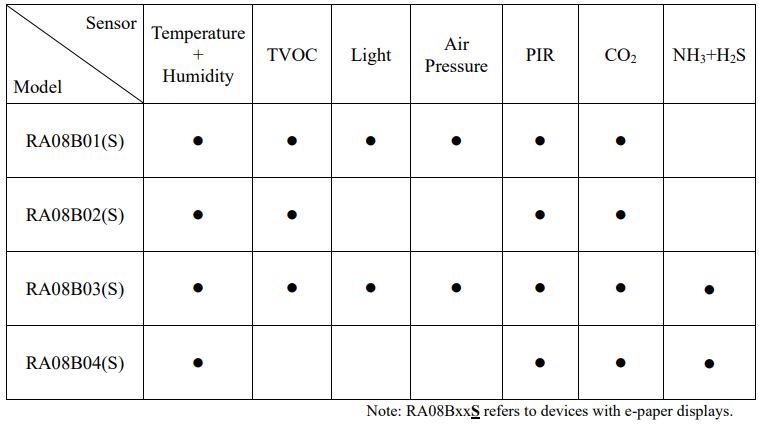
LoRa Wireless Technology:
LoRa is a wireless communication technology that adopts techniques such as long-distance communication and low power consumption. Compared with other communication methods, LoRa spread-spectrum modulation techniques greatly expand the communication distance. It is used in long-distance and low-data wireless communications like automatic meter reading, building automation equipment, wireless security systems, and industrial monitoring control system. The features include small size, low power consumption, long transmission distance, and anti-interference ability.
LoRaWAN:
LoRaWAN built LoRa’s end-to-end standards and techniques, ensuring interoperability between devices and gateways from different manufacturers.
2. Appearance

3. Features
- SX1262 wireless communication module
- 4 ER14505 battery in parallel (AA size 3.6V for each battery)
- Temperature/Humidity, CO2, PIR, air pressure, illuminance, TVOC, and NH3/H2S detection
- Compatible with LoRaWANTM Class A device
- Frequency hopping spread spectrum
- Support third-party platforms: Actility/ThingPark, TTN, MyDevices/Cayenne
- Low-power design for longer battery life
Note: Please refer to http://www.netvox.com.tw/electric/electric_calc.html for battery life calculation and other detailed information
4. Set-up Instruction
4.1 On/Off

4.2 Network Joining

4.3 Function Key
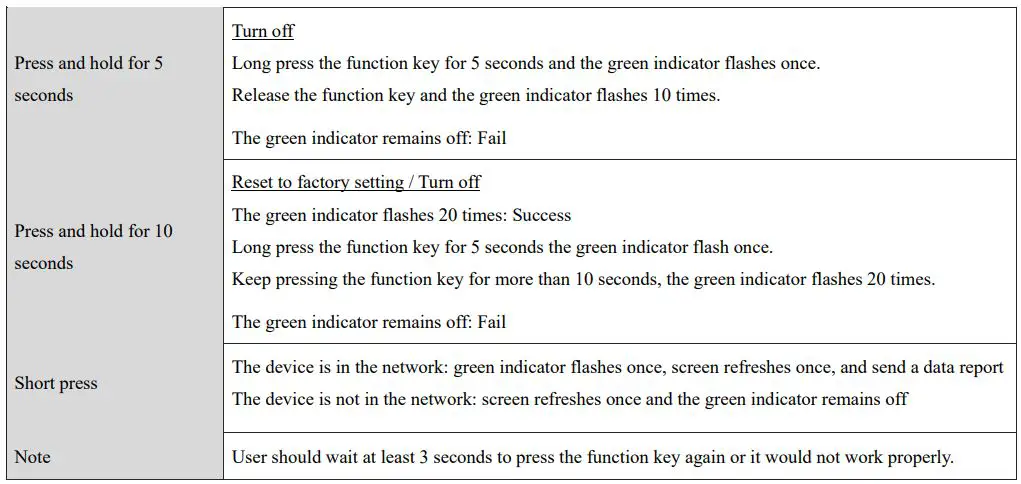
4.4 Sleeping Mode

4.5 Low Voltage Warning

5. Data Report
After power on, the device would refresh the information on the e-paper display and send a version packet report along with an uplink packet. The device sends data based on the default configuration when no configuration is done. Please do not send commands without turning on the device.
Default Setting:
Max Interval: 0x0708 (1800s)
Min Interval: 0x0708 (1800s) // The Max and Min Interval shall not be less than 180s.
IRDisableTime: 0x001E (30s)
IRDectionTime: 0x012C (300s)
CO2:
(1) Fluctuation of CO2 data caused by delivery and storage time could be calibrated.
(2) Please refer to 5.2 Example of ConfigureCmd and 7. CO2 Sensor Calibration for detailed information.
TVOC:
- Two hours after power on, the data sent by TVOC sensor are for reference only.
- If the data is way higher or below the setting, the device should be placed in the environment with fresh air in 24 to 48 hours until the data is back to normal value.
- TVOC level:

The information shown on the screen is based on user’s choice of sensor. It would be refreshed by pressing the function key, triggering the PIR, or refreshed based on the report interval. // FFFF of reported data and “–” on the screen means the sensors are turning on, disconnected, or errors of sensors.
Data Collecting and Transmission:
(1) Join the network:
Press the function key (indicator flashes once) / trigger PIR, read data, refresh screen, report detected data (based on the report interval)
(2) Without joining the network: Press the function key / trigger PIR to get data and refresh the information on the screen.
//ACK = 0x00 (OFF), interval of data packets = 10s;
//ACK = 0x01 (ON), interval of data packets = 30s (cannot be configured)
Note: Please refer Netvox LoRaWAN Application Command document and Netvox Lora Command Resolver http://www.netvox.com.cn:8888/cmddoc to resolve uplink data.
Data report configuration and sending period are as follows:

5.1 Example of ReportDataCmd
FPort: 0x06

Version– 1 bytes –0x01——the Version of NetvoxLoRaWAN Application Command Version
DeviceType– 1 byte – Device Type of Device
The devicetype is listed in Netvox LoRaWAN Application Devicetype V1.9.doc
ReportType –1 byte–The presentation of the Netvox PayLoad Data,according the device type
NetvoxPayLoadData– Fixed bytes (Fixed =8bytes)
Tips
- Battery Voltage: The voltage value is bit 0 ~ bit 6, bit 7=0 is normal voltage, and bit 7=1 is low voltage. Battery=0xA0, binary=1010 0000, if bit 7= 1, it means low voltage. The actual voltage is 0010 0000 = 0x20 = 32, 32*0.1v =3.2v
- Version Packet: When Report Type=0x00 is the version packet, such as 01A0000A01202307030000, the firmware version is 2023.07.03.
- Data Packet: When Report Type=0x01 is data packet. (If the device data exceeds 11 bytes or there are shared data packets, the Report Type will have different values.)
- Signed Value: When the temperature is negative, 2’s complement should be calculated.

Uplink:
Data #1: 01A0019F097A151F020C01
1st byte (01): Version
2nd byte (A0): DeviceType 0xA0 - RA08B Series
3rd byte (01): ReportType
4th byte (9F): Battery-3.1V (Low Voltage) Battery=0x9F, binary=1001 1111, if bit 7= 1, it means low voltage.
The actual voltage is 0001 1111 = 0x1F = 31, 31*0.1v =3.1v
5th 6th byte (097A): Temperature-24.26℃, 97A (Hex)= 2426 (Dec), 2426*0.01℃ = 24.26℃
7th 8th byte (151F): Humidity-54.07%, 151F (Hex) = 5407 (Dec), 5407*0.01% = 54.07%
9th 10th byte (020C): CO2-524ppm , 020C (Hex) = 524 (Dec), 524*1ppm = 524 ppm
11th byte (01): Occupy- 1
Data #2 01A0029F0001870F000032
1st byte (01): Version
2nd byte (A0): DeviceType 0xA0 - RA08B Series
3rd byte (02): ReportType
4th byte (9F): Battery-3.1V (Low Voltage) Battery=0x9F, binary=1001 1111, if bit 7= 1, it means low voltage.
The actual voltage is 0001 1111 = 0x1F = 31, 31*0.1v =3.1v
5th-8th byte (0001870F): Air Pressure-1001.11hPa, 001870F (Hex) = 100111 (Dec), 100111*0.01hPa = 1001.11hPa
9th-11th byte (000032): illuminance-50Lux, 000032 (Hex) = 50 (Dec), 50*1Lux = 50Lux
Data #3 01A0039FFFFFFFFF000007
1st byte (01): Version
2nd byte (A0): DeviceType 0xA0 - RA08B Series
3rd byte (03): ReportType
4th byte (9F): Battery-3.1V (Low Voltage) Battery=0x9F, binary=1001 1111, if bit 7= 1, it means low voltage.
The actual voltage is 0001 1111 = 0x1F = 31, 31*0.1v =3.1V
5th-6th (FFFF): PM2.5 - NA ug/m3
7th-8th byte (FFFF): PM10 - NA ug/m3
9th-11th byte (000007): TVOC-7ppb, 000007 (Hex) = 7 (Dec), 7*1ppb = 7ppb
Note: FFFF refers to unsupported detection item or errors.
Data #5 01A0059F00000001000000
1st byte (01): Version
2nd byte (A0): DeviceType 0xA0 - RA08B Series
3rd byte (05): ReportType
4th byte (9F): Battery-3.1V (Low Voltage) Battery=0x9F, binary=1001 1111, if bit 7= 1, it means low voltage.
The actual voltage is 0001 1111 = 0x1F = 31, 31*0.1v =3.1v
5th-8th (00000001): ThresholdAlarm-1 = 00000001(binary), bit0 = 1 (TemperatureHighThresholdAlarm)
9th-11th byte (000000): Reserved
Data #6 01A0069F00030000000000
1st byte (01): Version
2nd byte (A0): DeviceType 0xA0 - RA08B Series
3rd byte (06): ReportType
4th byte (9F): Battery-3.1V (Low Voltage) Battery=0x9F, binary=1001 1111, if bit 7= 1, it means low voltage.
The actual voltage is 0001 1111 = 0x1F = 31, 31*0.1v =3.1v
5th-6th (0003): H2S-0.03ppm, 3 (Hex) = 3 (Dec), 3* 0.01ppm = 0.03ppm
7th-8th (0000): NH3-0.00ppm
9th-11th byte (000000): Reserved
5.2 Example of ConfigureCmd
FPort: 0x07
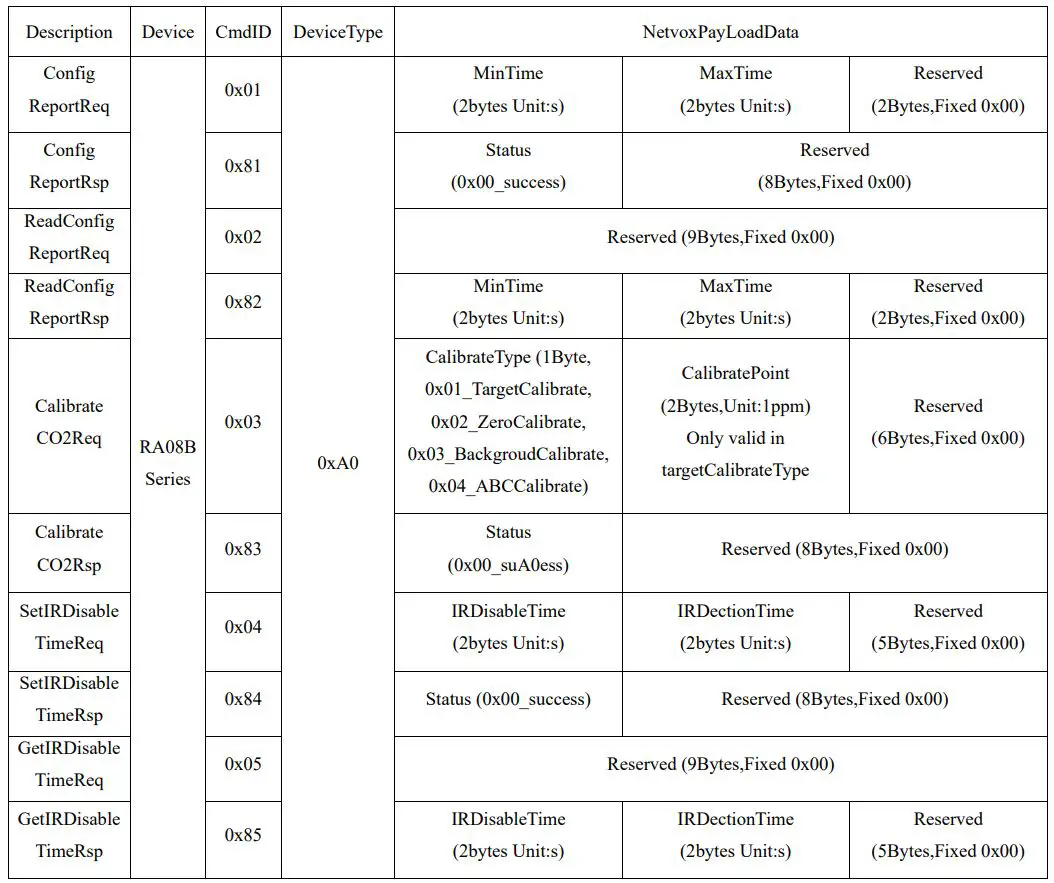
- Configure device parameters
MinTime = 1800s (0x0708), MaxTime = 1800s (0x0708)
Downlink: 01A0070807080000000000
Response:
81A0000000000000000000 (Configuration success)
81A0010000000000000000 (Configuration failure) - Read device configuration parameters
Downlink: 02A0000000000000000000
Response: 82A0070807080000000000 (Current configuration) - Calibrate CO2 sensor parameters
Downlink: 03A00103E8000000000000 // Choose Target-calibrations
(calibrate as the CO2 level reaches 1000ppm) (CO2 level could be configured)
03A0020000000000000000 //Choose Zero-calibrations (calibrate as the CO2 level is 0ppm)
03A0030000000000000000 //Choose Background-calibrations (calibrate as the CO2 level is 400ppm)
03A0040000000000000000 //Choose ABC-calibrations
(Note: The device would auto-calibrate as it turns on. The interval of auto-calibration would be 8 days. The device shall be exposed to the environment with fresh air at least 1 time to ensure the accuracy of the results.)
Response:
83A0000000000000000000 (Configuration success) // (Target/Zero/Background/ABC-calibrations)
83A0010000000000000000 (Configuration failure) // After calibration, the CO2 level exceeds the accuracy range. - SetIRDisableTimeReq
Downlink: 04A0001E012C0000000000 //IRDisableTime: 0x001E=30s, IRDectionTime: 0x012C=300s
Response: 84A0000000000000000000 (Current configuration) - GetIRDisableTimeReq
Downlink: 05A0000000000000000000
Response: 85A0001E012C0000000000 (Current configuration)
5.3 ReadBackUpData
FPort: 0x0C

Uplink
Data #1 91099915BD01800100002E
1st byte (91): CmdID
2nd- 3rd byte (0999): Temperature1-24.57°C, 0999 (Hex) = 2457 (Dec), 2457 * 0.01°C = 24.57°C
4th-5th byte (15BD): Humidity-55.65%, 15BD (Hex) = 5565 (Dec), 5565 * 0.01% = 55.65%
6th-7th byte (0180): CO2-384ppm, 0180 (Hex) = 384 (Dec), 384 * 1ppm = 384ppm
8th byte (01): Occupy
9th-11th byte (00002E): illuminance1-46Lux, 00002E (Hex) = 46 (Dec), 46 * 1Lux = 46Lux
Data #2 9200018C4A000007000000
1st byte (92): CmdID
2nd- 5th byte (00018C4A): AirPressure-1014.50hPa, 00018C4A (Hex) = 101450 (Dec), 101450 * 0.01hPa = 1014.50hPa
6th-8th byte (000007): TVOC-7ppb, 000007(Hex)=7(Dec),7*1ppb=7ppb
9th-11th byte (000000): Reserved
Data #3 93FFFFFFFFFFFFFFFFFFFF
1st byte (93): CmdID
2nd- 3rdbyte (FFFF): PM2.5-FFFF(NA)
4th-5th byte (FFFF): PM10-FFFF(NA)
6th-7th byte (FFFF): HCHO-FFFF(NA)
8th-9th byte (FFFF): O3-FFFF(NA)
10th-11th byte (FFFF): CO-FFFF(NA)
Data #4 9400010000000000000000
1st byte (94): CmdID
2nd- 3rdbyte (0001): H2S-0.01ppm, 001(Hex) = 1 (Dec), 1* 0.01ppm = 0.01ppm
4th-5th byte (0000): NH3-0ppm
6th-11th byte (000000000000): Reserved
5.4 Example of GlobalCalibrateCmd
FPort: 0x0E
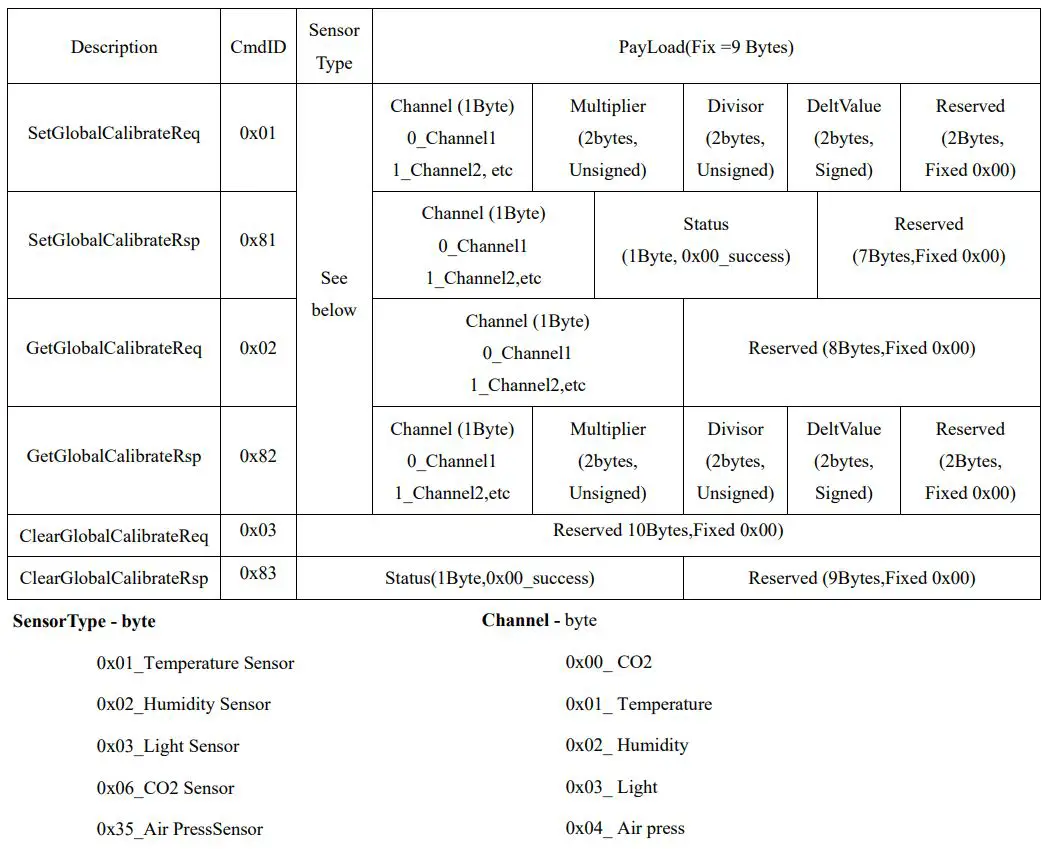
- SetGlobalCalibrateReq
A. Calibrate the RA08B Series CO2 sensor by increasing 100ppm.
SensorType: 0x06; Channel: 0x00; Multiplier: 0x0001; Divisor: 0x0001; DeltValue: 0x0064
Downlink: 0106000001000100640000
Response: 8106000000000000000000
B. Calibrate the RA08B Series CO2 sensor by decreasing 100ppm.
SensorType: 0x06; Channel: 0x00; Multiplier: 0x0001; Divisor: 0x0001; DeltValue: 0xFF9C
SetGlobalCalibrateReq:
Downlink: 01060000010001FF9C0000
Response: 8106000000000000000000 - GetGlobalCalibrateReq
A. Downlink: 0206000000000000000000
Response:8206000001000100640000
B. Downlink: 0206000000000000000000
Response: 82060000010001FF9C0000 - ClearGlobalCalibrateReq:
Downlink: 0300000000000000000000
Response: 8300000000000000000000
5.5 Set/GetSensorAlarmThresholdCmd
FPort: 0x10 CmdID
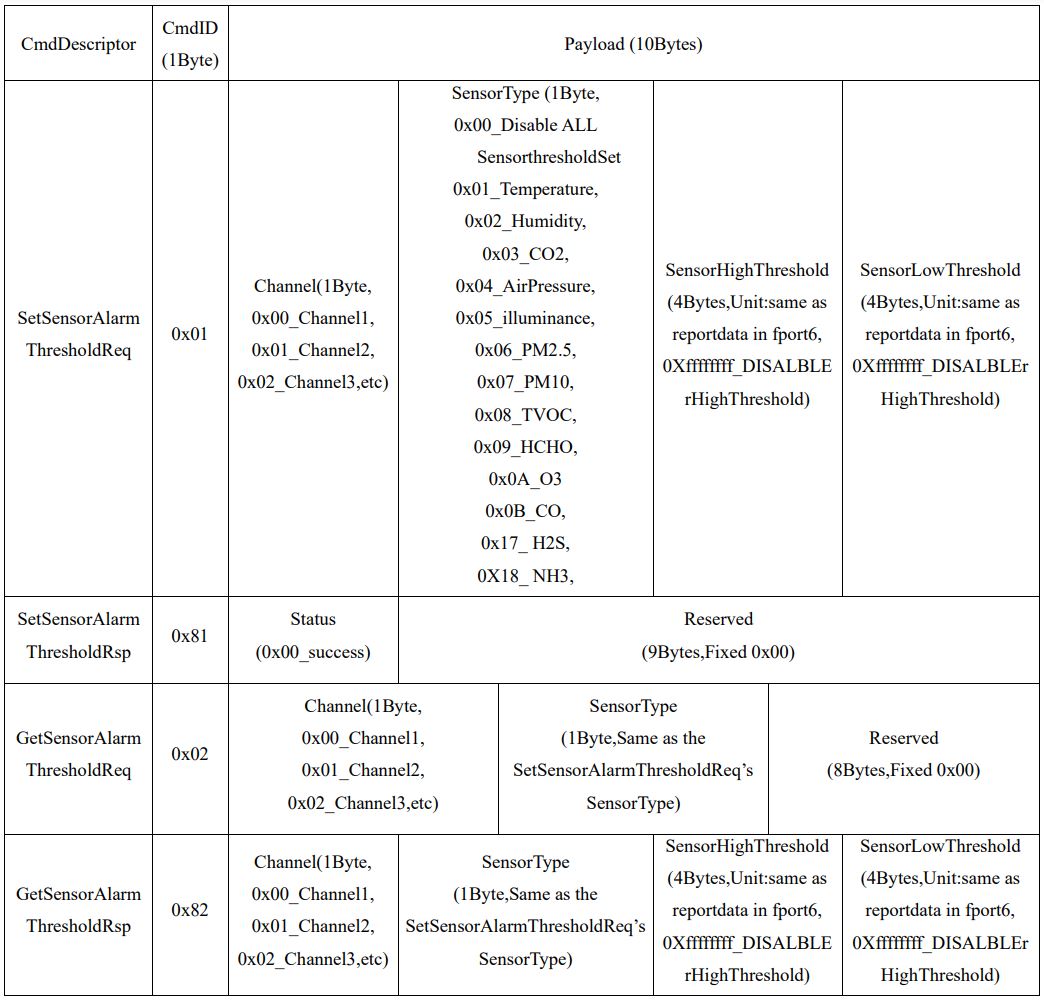
Default: Channel = 0x00 (cannot be configured)
- Set the temperature HighThreshold as 40.05℃ and LowThreshold as 10.05℃
SetSensorAlarmThresholdReq: (when the temperature is higher than the HighThreshold or lower than the LowThreshold, the device would upload reporttype = 0x05)
Downlink: 01000100000FA5000003ED // 0FA5 (Hex) = 4005 (Dec), 4005*0.01°C = 40.05°C, 03ED (Hex) = 1005 (Dec), 1005*0.01°C = 10.05°C
Response: 810001000000000000000000 - GetSensorAlarmThresholdReq
Downlink: 0200010000000000000000
Response:82000100000FA5000003ED - Disable all sensor thresholds. (Configure the Sensor Type to 0)
Downlink: 0100000000000000000000
Device returns: 8100000000000000000000
5.6 Set/GetNetvoxLoRaWANRejoinCmd
(To check if the device is still in the network. If the device is disconnected, it will automatically rejoin back to the network.)
FPort: 0x20
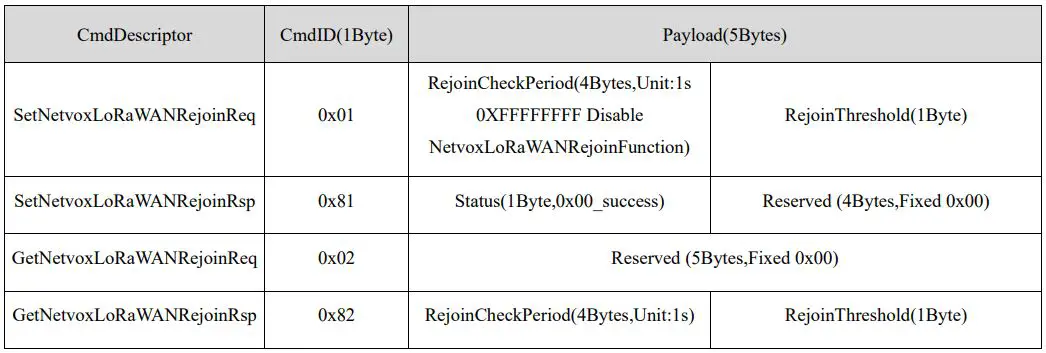
Note: (a) Set RejoinCheckThreshold as 0xFFFFFFFF to stop the device from rejoining the network.
(b) The last configuration would be kept as users reset the device back to the factory setting.
(c) Default setting: RejoinCheckPeriod = 2 (hr) and RejoinThreshold = 3 (times)
(1) Configure device parameters
RejoinCheckPeriod = 60min (0x00000E10), RejoinThreshold = 3 times (0x03)
Downlink: 0100000E1003
Response: 810000000000 (configuration success)
810100000000 (configuration fail)
(2) Read configuration
Downlink: 020000000000
Response: 8200000E1003
6. Information about Battery Passivation
Many of Netvox devices are powered by 3.6V ER14505 Li-SOCl2 (lithium-thionyl chloride) batteries that offer many advantages including low self-discharge rate and high energy density. However, primary lithium batteries like Li-SOCl2 batteries will form a passivation layer as a reaction between the lithium anode and thionyl chloride if they are in storage for a long time or if the storage temperature is too high. This lithium chloride layer prevents rapid self-discharge caused by continuous reaction between lithium and thionyl chloride, but battery passivation may also lead to voltage delay when the batteries are put into operation, and our devices may not work correctly in this situation.
As a result, please make sure to source batteries from reliable vendors, and it is suggested that if the storage period is more than one month from the date of battery production, all the batteries should be activated. If encountering the situation of battery passivation, users can activate the battery to eliminate the battery hysteresis.
ER14505 Battery Passivation:
6.1 To determine whether a battery requires activation
Connect a new ER14505 battery to a resistor in parallel, and check the voltage of the circuit. If the voltage is below 3.3V, it means the battery requires activation.
6.2 How to activate the battery
- a. Connect a battery to a resistor in parallel
- b. Keep the connection for 5~8 minutes
- c. The voltage of the circuit should be 3.3, indicating successful activation.

Battery activation time, activation current, and load resistance may vary due to the manufacturers. Users should follow the manufacturer’s instructions before activating the battery.
Note: (a) Please do not disassemble the device unless it is required to replace the batteries.
(b) Do not move the waterproof gasket, LED indicator light, and function keys when replacing the batteries.
(c) Please use a suitable screwdriver to tighten the screws. If using an electric screwdriver, user should set the torque as 4kgf to ensure the device is impermeable.
(d) Please do not dissemble the device with little understanding of the device’s internal structure.
(e) The waterproof membrane stops liquid water from passing into the device. However, it does not contain a water vapor barrier. To prevent water vapor from condensing, the device should not be used in an environment that is highly humid or full of vapor.
7. CO2 Sensor Calibration
- Target Calibration Target concentration calibration assumes that sensor is put into a target environment with a known CO2 concentration. A target concentration value must be written to Target calibration register.
- Zero Calibration Zero-calibrations are the most accurate recalibration routine and are not at all affected performance-wise by having an available pressure sensor on host for accurate pressure-compensated references. A zero-ppm environment is most easily created by flushing the optical cell of the sensor module and filling up an encapsulating enclosure with nitrogen gas, N2, displacing all previous air volume concentrations. Another less reliable or accurate zero reference point can be created by scrubbing an airflow using e.g. Soda lime.
- Background Calibration A “fresh air” baseline environment is by default 400ppm at normal ambient atmospheric pressure by sea level. It can be referenced in a crude way by placing the sensor in direct proximity to outdoor air, free of combustion sources and human presence, preferably during either by open window or fresh air inlets or similar. Calibration gas by exactly 400ppm can be purchased and used.
- ABC Calibration The Automatic Baseline Correction algorithm is a proprietary Senseair method for referencing to “fresh air” as the lowest, but required stable, CO2-equivalent internal signal the sensor has measured during a set time period. This time period by default is 180hrs and can be changed by the host, it’s recommended to be something like an 8 day period as to catch low-occupancy and other lower-emission time periods and favourable outdoor wind-directions and similar which can plausibly and routinely expose the sensor to the most true fresh air environment. If such an environment can never be expected to occur, either by sensor locality or ever-presence of CO2 emission sources, or exposure to even lower concentrations than the natural fresh air baseline, then ABC recalibration can’t be used. In each new measurement period, the sensor will compare it to the stored one at the ABC parameters registers, and if new values show a lower CO2-equivalent raw signal while also in a stable environment, the reference is updated with these new values. The ABC algorithm also has a limit on how much it is allowed to change the baseline correction offset with, per each ABC cycle, meaning that self-calibrating to adjust to bigger drifts or signal changes may take more than one ABC cycle.
8. Important Maintenance Instructions
Kindly pay attention to the following in order to achieve the best maintenance of the product:
- Do not put the device near or submerge into water. Minerals in rain, moisture, and other liquids could cause corrosion of electronic components. Please dry the device, if it gets wet.
- Do not use or store the device in dusty or dirty environments to prevent damage to parts and electronic components.
- Do not store the device in high temperatures. This may shorten the lifespan of electronic components, damage batteries, and deform plastic parts.
- Do not store the device in cold temperatures. Moisture may damage circuit boards as the temperatures rise.
- Do not throw or cause other unnecessary shocks to the device. This may damage internal circuits and delicate components. · Do not clean the device with strong chemicals, detergents, or strong detergents.
- Do not apply the device with paint. This may block detachable parts and cause malfunction.
- Do not dispose of batteries in fire to prevent explosion.
The instructions are applied to your device, battery, and accessories. If any device is not working properly or has been damaged, please send it to the nearest authorized service provider for service.
Documents / Resources
 |
netvox RA08Bxx-S Series Wireless Multi Sensor Device [pdf] User Manual RA08Bxx-S Series, RA08Bxx-S Series Wireless Multi Sensor Device, Wireless Multi Sensor Device, Multi Sensor Device, Sensor Device, Device |